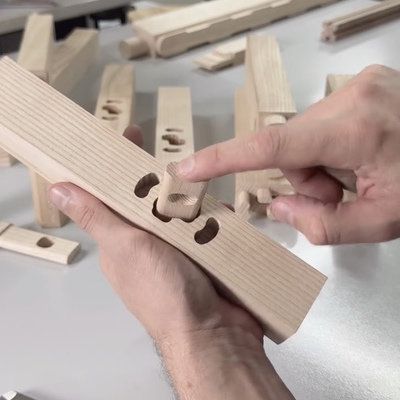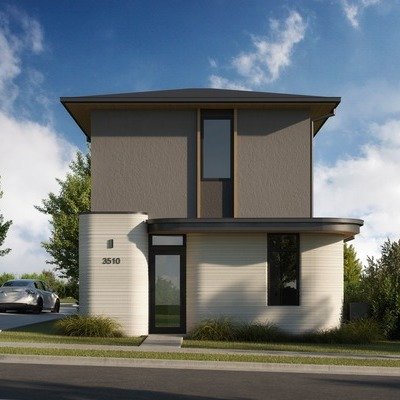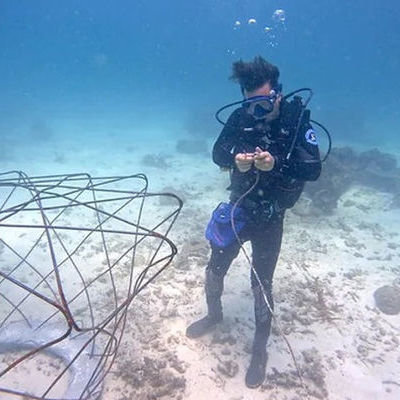e
Rob Wilkey
Atlanta, GA, USA
Favorites & Upvotes
- 16 Favorited Articles
Comments
- 12 Comments
Upvoted Guide Items
Favorited Articles
-
Industrial Designer Develops Unusual Wooden Connectors for Flatpack Furniture
Although flatpack furniture is typically made of wood, the connectors are almost always metal....
3 Comments 9 Favorites -
In Texas, 3D Printed Homes Inch Closer to Being Affordable
Icon gets an assist from the Mueller Foundation
3 Comments -
-
-
-
Mafell's Crazy Pull-Push Portable Table Saw
The Erika 85 makes American contractor saws look primitive
3 Comments -
The Newave: A Modular Surfboard that Breaks Down for Transport
Tool-free assembly in under a minute
1 Comment -
Algorithmic Artificial Reef: from Industrial Design School Project to Legacy at Sea
Leo Hummel put his "SeaWeaver" to the test in the waters of Thailand before passing
-
Transportation Designer Turns Xmas Card Concept Sketch into Real Electric Motorcycle
The Rocket One, by Alan Derosier
-
Architecture Collective Creates Tiny House from Decommissioned Wind Turbine Nacelle
A collaboration between Superuse and Vattenfall
7 Favorites -
Form Follows Function: A Clever Norwegian Design Feature for Barns
Barns in Scandinavia have steeply-pitched roofs, to deal with heavy snow loads. A steeply-pitched...
1 Comment 5 Favorites -
Expertly Blending Modelmaking, Photography and Digital Compositing
Stellar work by Felix Alejandro Hernandez
Favorited News Items
Comments
-
"The number of times that "AI live translation earbuds" have been advertised is exactly equal to the number of times those products have been useless vaporware bullshit"on: Language-Translating Earbuds That Use Bone Conduction for Noisy Environments
-
"That's Bucky Lasek's (of skateboarding fame) Subaru XT-6. Absolute legend."on: Retro-Futuristic Forged Automotive Rims by Concept Car Studio
-
"We started using one of these in our office a few years ago, and it works quite well! I think the best feature of it is that keeps the solder wire straighter and stiffer than if you were trying to hold it with just your thumb and finger. Not to mention that it obviates the need for a spool taking up space on your desk that you'll inevitably bump with your arm while trying to work."on: Clever Design for an Easy-to-Use 3D-Printed Solder Dispenser
-
"I hate to be that guy but why do so many of these look extremely suspiciously like AI-generated images?"on: Daniel Brandt's Insane Portfolio of Custom Pool Tables
-
"Yeah, the vision for Dulles was way ahead of its time. This concept was revolutionary and was a huuuuge step forward in terns of convenience and comfort for the time. Keep in mind, people were still usually boarding aircraft by walking across the tarmac to boarding stairs during this time, and this was even a huge improvement over jet bridges because passengers didn't have to walk nearly as far to board their planes. Saarinen envisioned these vehicles as being large, lavish, air-conditioned lounged with bar service and couches. The reality of building a vehicle of that scale and keeping it as maneuverable as it needs to be was unfortunately untenable at the time. And with risks of ramp-rash (vehicles hitting planes and damaging them), changing aircraft types, and the advantageous factors of remote boarding just not having that much importance at the time, the concept was gradually abandoned - except for using the vehicles to move people between the terminals, as you mentioned.With changes in aircraft types moving towards mass adoption of high-capacity single-aisle craft which take an untenably long time to board, airports by and large being real-estate locked at this point, dramatically higher and ever increasing demand for air travel, and modern ground vehicle technology, this concept is back to making a whole lot of sense. With modern technology and modern demands, we might finally have the opportunity to see Eero's vision fulfilled."on: Industrial Design Case Study: A Mobile Airport Lounge
-
"Using the term "gaudy" to describe this feels like using the term "unpleasant" to describe the sensation of burning alive. It's a disservice to mankind that people spent time designing and building this throne to waste"on: Mercedes-Benz's Over-the-Top Luxury Limousine EV
-
"how did all of you miss SLEEK?"on: This "Corporate Nonsense Generator" Needs a Product Design Version
-
"the whole video is ai-generated. there is nothing tangible here"on: Teaser: A Beautiful Ross Lovegrove Design for a Flexing Robot Arm
-
"I'm not sure what exactly you're alluding to with this comment and graphic, but to address a number of possible topics:•What you're displaying in this graphic is the boarding of a widebody aircraft with two (technically 4) front boarding doors. While mobile lounges could be used to board both of these front doors, widebody (dual aisle) aircraft are not the initial design target, as their boarding process is already more streamlined and doesn't suffer from the bottleneck that high-capacity narrowbody aircraft struggle with. Dual-bridge boarding of narrowbody aircraft has been attempted many times and has been ubiquitously scrapped, because you either have to occupy too much linear real estate on a boarding pier at the airport, or it requires a complex, overbuilt structure that spans over the aircraft wing. These have failed too often for the approach to be feasible.•If you're pointing out the complexity of ground operations around the aircraft during a turnaround, it is indeed a crowded and busy space! However, the aft left-side door is most commonly only occupied by cabin cleaning or galley service vehicles, and only for a short period during the turnaround. Connecting a boarding vehicle to this door during unloading and loading of passengers actually increases the time window during which a service vehicle can dock at this door, as the passengers will be off of the plane faster (and need less time to board), allowing these crews more time to complete their work.Hope this answered any questions you might have. Feel free to ask more."on: Industrial Design Case Study: A Mobile Airport Lounge
-
"Extremely telling that there isn't a single image of a human riding it. All gesture, no comfort. Not everything needs to be bled dry on the altar of uniqueness."on: Designer on a Sci-Fi Mission: Daryl Villanueva's EVE Odyssey
-
"It does seem super compelling, but I can't seem to find literally any info on how it *actually works*I hate to be that guy, but when fantastic claims like this are made without any form of explanation of how it functions, it really discredits our industry"on: Sustainable Design is JUST. GOOD. DESIGN.
-
"my guess is they didn't plan to. likely did this to protect equipment and keep the place running for the patients who couldn't be transferred out easily, planning to hunker down with a limited staff to ride out the flood"on: AquaFence's Clever Design for Anti-Flooding Barriers
Guide Items Published
Reader Projects Published
Holiday Gift Guides
Blog Posts
Gallery Posts
K
{Welcome
Create a Core77 Account
Already have an account? Sign In
By creating a Core77 account you confirm that you accept the Terms of Use
K
Reset Password
Please enter your email and we will send an email to reset your password.












